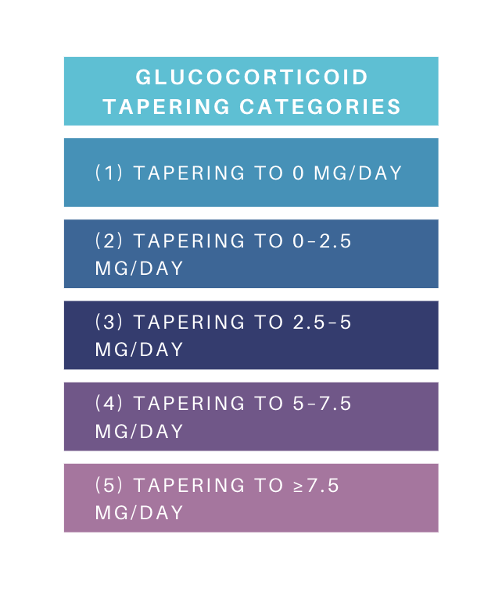Article
Tapering Glucocorticoids >2.5 mg/day Effectively Reduces Flare Risk in Patients with Rheumatoid Arthritis
Author(s):
Despite EULAR recommendations encouraging the tapering of glucocorticoids and the rapidly expanding treatment options for patients with rheumatoid arthritis, glucocorticoids are still commonly prescribed to reduce inflammation and manage disease activity.
In patients with rheumatoid arthritis (RA), tapering doses of glucocorticoids >2.5 mg/day was effective in minimizing risk of flare, while risk was higher in those tapering ≤2.5 mg/day, according to a study published in Rheumatic and Musculoskeletal Diseases.1 Investigators are hopeful that the findings can help design new tapering strategies for this patient population.

“Treatment options for RA are rapidly expanding but glucocorticoids are still largely prescribed to reduce inflammation and control disease activity,” investigators explained. “Tapering glucocorticoids to the lowest dose possible is strongly encouraged by the 2019 European League Against Rheumatism (EULAR) recommendations for the management of RA.”
A case-crossover study analyzed factors linked to a higher risk of flare in patients with RA using demographic and clinical data from the outpatient service of the Rheumatology Unit of the University of Verona. Follow-up visits were conducted every 3-4 months. Time-varying factors were evaluated before events, called hazard periods, as well as before control periods. Time-varying factors included biological disease-modifying antirheumatic drug (bDMARD) use, disease activity, and use of nonsteroidal anti-inflammatory drugs (NSAIDs). The hazard periods were classified as the 6 months immediately before flares and control periods were the 6 months prior to clinical visits without flare. The tapering of medications to various doses was assessed, with investigators categorizing patients into 5 groups: (1) tapering to 0 mg/day, (2) tapering to 0–2.5 mg/day, (3) tapering to 2.5–5 mg/day, (4) tapering to 5–7.5 mg/day, and (5) tapering to ≥7.5 mg/day.
Of the 508 patients included in the study, 52.5% (n = 267) reported at least 1 flare and were placed in the case-crossover study population, allowing for the data collection of 1545 clinical visits. Glucocorticoid tapering was performed in 81.5% (n = 216) patients in this group and discontinuation was achieved 1 or more times in 57.5% (n = 125) of these patients. During the study period, 22.3% (n = 345) of patients experienced a flare.
The highest risk of flare was seen in patients discontinuing bDMARDs and tapering 0-2.5 mg/day (adjusted odds ratio (aOR) of 1.45, 95% CI: 1.13 to 2.24 and aOR of 1.37; 95% CI: 1.06 to 2.01, respectively). However, tapering >2.5 mg/day did not significantly increase flare risk, even after investigators utilized a different definition of flare. The AoRs for flare compared with no tapering were 1.29 (95% CI: 0.98 to 1.90) in the 2.5–5 mg/day group, 0.98 (95% CI: 0.68 to 1.61) in the 5–7.5 mg/day group, and 0.89 (95% CI: 0.39 to 2.10) for those tapering ≥7.5 mg/day.
A case-crossover study design was utilized to reduce confounding by indication bias. However, investigators note that results may not be generalizable to all patients with RA, such as those who are not recieving bDMARDs or those with early RA, who are often treated with glucocorticoids which may make the tapering of the medication easier. The single center nature of the study potentially created systematic bias towards tapering. Certain non-measured time-varying confounds, such as infections, may have skewed results as patients could have reduced bDMARDs because of a fear of adverse events or did not reduce the medication due to disease relapse fears. Future multicentric studies should assess the duplicability of the results.
“Our study might help define new glucocorticoid reducing strategies, which should aim to doses between 5 and 2.5 mg/day of prednisone equivalent,” investigators concluded.
Reference:
Adami G, Fassio A, Rossini M, et al. Tapering glucocorticoids and risk of flare in rheumatoid arthritis on biological disease-modifying antirheumatic drugs (bDMARDs). RMD Open. 2023;9(1):e002792. doi:10.1136/rmdopen-2022-002792





